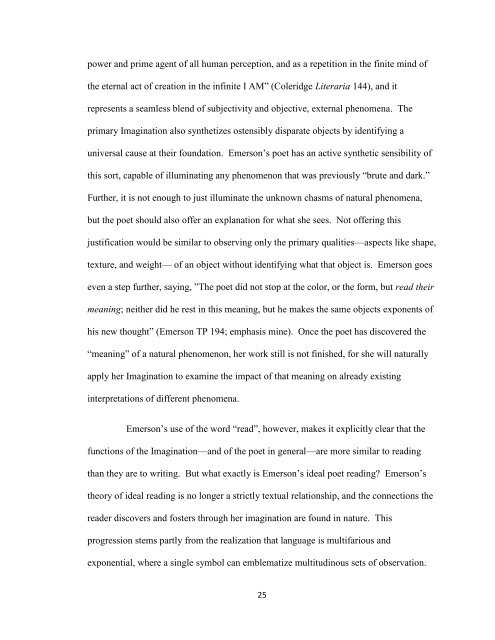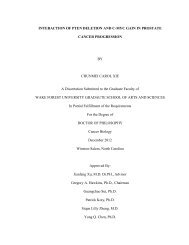RALPH WALDO EMERSON AND THE EVER-EVOLVING ART OF ...
RALPH WALDO EMERSON AND THE EVER-EVOLVING ART OF ...
RALPH WALDO EMERSON AND THE EVER-EVOLVING ART OF ...
You also want an ePaper? Increase the reach of your titles
YUMPU automatically turns print PDFs into web optimized ePapers that Google loves.
power and prime agent of all human perception, and as a repetition in the finite mind of<br />
the eternal act of creation in the infinite I AM” (Coleridge Literaria 144), and it<br />
represents a seamless blend of subjectivity and objective, external phenomena. The<br />
primary Imagination also synthetizes ostensibly disparate objects by identifying a<br />
universal cause at their foundation. Emerson’s poet has an active synthetic sensibility of<br />
this sort, capable of illuminating any phenomenon that was previously “brute and dark.”<br />
Further, it is not enough to just illuminate the unknown chasms of natural phenomena,<br />
but the poet should also offer an explanation for what she sees. Not offering this<br />
justification would be similar to observing only the primary qualities—aspects like shape,<br />
texture, and weight— of an object without identifying what that object is. Emerson goes<br />
even a step further, saying, ”The poet did not stop at the color, or the form, but read their<br />
meaning; neither did he rest in this meaning, but he makes the same objects exponents of<br />
his new thought” (Emerson TP 194; emphasis mine). Once the poet has discovered the<br />
“meaning” of a natural phenomenon, her work still is not finished, for she will naturally<br />
apply her Imagination to examine the impact of that meaning on already existing<br />
interpretations of different phenomena.<br />
Emerson’s use of the word “read”, however, makes it explicitly clear that the<br />
functions of the Imagination—and of the poet in general—are more similar to reading<br />
than they are to writing. But what exactly is Emerson’s ideal poet reading? Emerson’s<br />
theory of ideal reading is no longer a strictly textual relationship, and the connections the<br />
reader discovers and fosters through her imagination are found in nature. This<br />
progression stems partly from the realization that language is multifarious and<br />
exponential, where a single symbol can emblematize multitudinous sets of observation.<br />
25




